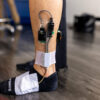For years, we’ve been told that sugar is a major culprit behind the global rise in type 2 diabetes. Now, emerging evidence from BYU researchers adds nuance to that message, suggesting that not all sugar sources carry the same risk.
The study is published in the journal Advances in Nutrition.
In the largest and most comprehensive meta-analysis of its kind, BYU researchers—in collaboration with researchers from Germany-based institutions—found that the type and source of sugar may matter far more than previously thought. Researchers analyzed data from over half a million people across multiple continents, revealing a surprising twist: Sugar consumed through beverages—like soda and even fruit juice—was consistently linked to a higher risk of developing type 2 diabetes (T2D). Meanwhile, other sugar sources showed no such link, and in some cases, were even associated with a lower risk.
“This is the first study to draw clear dose-response relationships between different sugar sources and type 2 diabetes risk,” said Karen Della Corte, lead author and BYU nutritional science professor. “It highlights why drinking your sugar—whether from soda or juice—is more problematic for health than eating it.”
After correcting for body mass index, excess energy intake and several other lifestyle risk factors, the researchers found the following dose-response relationships:
With each additional 12-oz serving of sugar-sweetened beverages (i.e., soft drinks, energy drinks and sports drinks) per day, the risk of developing T2D increased by 25%. This strong relationship showed that the increased risk began from the very first daily serving with no minimum threshold below which intake appeared to be safe.
With each additional 8-oz serving of fruit juice per day (i.e., 100% fruit juice, nectars and juice drinks), the risk of developing T2D increased by 5%.
The above risks are relative not absolute. For example, if the average person’s baseline risk of developing T2D is about 10%, four sodas a day could raise that to roughly 20%, not 100%.
Comparatively, 20 g/day intakes of total sucrose (table sugar) and total sugar (the sum of all naturally occurring and added sugars in the diet) showed an inverse association with T2D, hinting at a surprising protective association.
Why drinking sugar would be more problematic than eating sugar may come down to the differing metabolic effects. Sugar-sweetened beverages and fruit juice supply isolated sugars, leading to a greater glycemic impact that would overwhelm and disrupt liver metabolism, thereby increasing liver fat and insulin resistance.
On the other hand, dietary sugars consumed in or added to nutrient-dense foods, such as whole fruits, dairy products, or whole grains, do not cause metabolic overload in the liver. These embedded sugars elicit slower blood glucose responses due to accompanying fiber, fats, proteins and other beneficial nutrients.
Fruit juice, even with some vitamins and nutrients, is much less beneficial. Because of its high and concentrated sugar content, the researchers conclude that fruit juice is a poor substitute for whole fruits, which provide more fiber to support better blood glucose regulation.
“This study underscores the need for even more stringent recommendations for liquid sugars such as those in sugar-sweetened beverages and fruit juice, as they appear to harmfully associate with metabolic health,” Della Corte said. “Rather than condemning all added sugars, future dietary guidelines might consider the differential effects of sugar based on its source and form.”
More information:
Karen A Della Corte et al, Dietary Sugar Intake and Incident Type 2 Diabetes Risk: A Systematic Review and Dose-Response Meta-Analysis of Prospective Cohort Studies, Advances in Nutrition (2025). DOI: 10.1016/j.advnut.2025.100413
Provided by
Brigham Young University
Citation:
Sugar consumed through soda, fruit juice consistently linked to higher risk of developing type 2 diabetes (2025, May 27)


